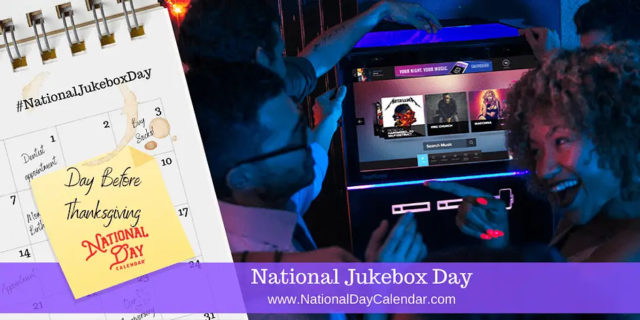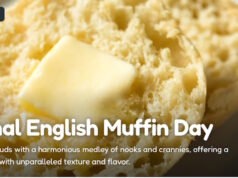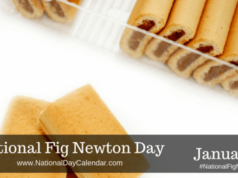
On the day before gathering around the turkey, gather around the nearest jukebox to celebrate National Jukebox Day! As Americans flock to their hometowns for Thanksgiving, many will head out to neighborhood bars and restaurants. They’ll catch up with friends and family and celebrate by playing great songs on their local jukebox.
- Emile Berliner paved the way for the transition process from cylinder-based phonographs to disc record-based ones when he marketed his gramophone in the 1890s.
- The name jukebox is thought to originate from places called ‘juke houses’ or ‘jook joints.’ In the early 1900s, people congregated in these establishments to drink and listen to music.
- The roots of the jukebox can be traced to 1877 and Thomas Edison, the man behind the camera and the light bulb. He invented the phonograph, a music device that could play recorded sound.
- In 1889, Louis Glass and his partner William S. Arnold invented the first coin-operated player in San Francisco. They were both managers of the Pacific Phonograph Co.
- Formally known as the nickel-in-the-slot machine, the player included a coin operation feature on an Edison phonograph. However, it played a limited selection of songs without any amplification.
- The first machine was installed at Palais Royal Saloon in San Francisco on November 23, 1889 — exactly 132 years ago today. Glass’s office was a mere two blocks away and he asked the bar manager if he could display the new-fangled machine to the public there. Not much is known about that first machine, as this establishment went under somewhere around 1890 and the San Francisco earthquake of 1906 destroyed everything around there, but during the first year of the jukebox, from autumn 1889 until summer 1890, quite a few coin-operated music machines were produced in that area.
- 1905: The “Automatic Entertainer” was introduced by John Gabel and included 24 song selections.
- Electronically recorded 78rpm records began replacing acoustic disc records around 1925-1926
- By 1927, The Automatic Music Instrument Company created the world’s first electrically amplified multi-selection phonograph. With this amplification, suddenly the Jukebox could compete with a large orchestra, for the cost of a nickel.
- Prohibition assured the jukebox’s success, as every underground speakeasy needed music, but could not afford a live band. Tavern owners were privileged to have a jukebox, which drew in customers, and was provided by an operator at no charge.
- The 1930s were considered the start of “The Golden Era” for jukeboxes as manufacturers including Rudolph Wurlitzer Co., The J. P. Seeburg Corp., The Rock-Ola Manufacturing Corp. and Automatic Musical Instrument Co., competed to produce them for diners, saloons and other entertainment locations.
- 1946 ushered in “The Silver Age” for jukeboxes as market demand for the newest and greatest technology soared. Fashionable and sleek, jukeboxes weren’t just music players, they were centerpieces often flamboyant with color and chrome. Neon and sci-fi became a tremendous influence on style as well.
- The 1960s was the start of a new modern age for jukeboxes. Designs of coin-operated models went through radical changes, not only because of the availability of new materials, such as plastic but also because of the need to accommodate customer demand for more song selection.
- In 1989, compact-disc mechanisms replaced the older record-style players as newer technology became affordable and rapidly implemented among the general population. Jukeboxes started to become more of a novelty than a necessity.
- In 1998, TouchTunes introduced the next major innovation for the industry with the launch of the first digital networked music jukebox. For the first time, customers could search and browse from a library with 750 digital songs.
- In 2010, TouchTunes released the first-ever social jukebox mobile app on iOS and Android. The app allows users to find nearby jukebox locations, create playlists, and queue up songs on the jukebox directly from their phone.
- In 2011, TouchTunes once again revolutionized in-venue entertainment with the launch of Virtuo, a multi-application platform designed to appeal a tech-savvy audience. Users could choose from hundreds of thousands of songs available.
- In 2014, TouchTunes introduced the next wave of innovation with Playdium, a smarter jukebox that dynamically updates the user experience to showcase the music most relevant to each location.
- In 2016, TouchTunes revamped the mobile app experience to allow music fans to be the DJ like never before. The advanced app offers an intuitive music-first design and improved usability to better control the jukebox.
- The biggest-selling jukebox of all time – and perhaps the image of a jukebox in most people’s minds – is the Wurlitzer 1015, introduced in 1946. Wurlitzer models featured flashing colored lights and bubble tubes, helping them become the centerpiece of any establishment.
- During the 1950s sales declined, partially after the invention of the transistor radio, the first affordable way for people to listen to the radio at home.
- The popularity of the Sony Walkman in the 1980s furthered the decline.
- Another detrimental blow to the jukebox’s popularity was the shift in teenager life away from hanging out at the diners and restaurants. The 1960s were the hippie era; it was also the beginning of Beatlemania and the mainstream success of rock concerts. Live music had recaptured the hearts of the youth. Teens suddenly had new places to go for both their music and their social lives.
- The number of jukeboxes sold each year has remained around 250,000 units ever since, thanks mostly to booming antiques and collectibles.
Sources:












